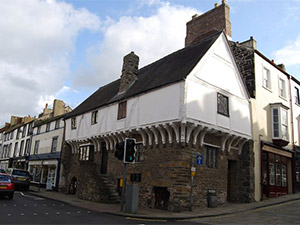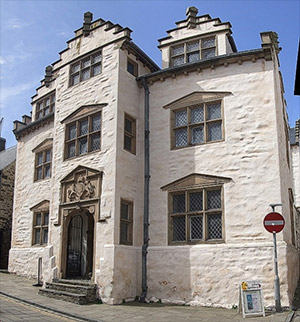Conwy, Conwy, Wales
Conwy Castle (courtesy of Dr. Volkmar Rudolf)
Aberconwy House

Aberconwy House is a medieval merchant's house - and one of the oldest and datable - in Wales. It was built around 1418-1419. It is a Grade I listed building and in the care of the National Trust.
The house is reputedly haunted by the apparition of a man in Victorian clothing that is seen downstairs, but also in the Jacobean parts of the building. The figure of a woman in Jacobean dress has also been sighted. Other phenomena include cold breezes, the sounds of footsteps, items disappear and reappear and a door slams shut. Pictured left is Aberconwy House courtesy of Nigel Chadwick.
Aberconwy House,
Castle Street,
Conwy,
LL32 8AY.
For further information, please read Ghosts: Mysterious Tales from the National Trust by Sian Evans.
Conwy Castle
Conwy Castle (Welsh: Castell Conwy) is a medieval fortification built by Edward I, during his conquest of Wales, between 1283 and 1289. It withstood the siege of Madog ap Llywelyn in the winter of 1294–95, acted as a temporary haven for Richard II in 1399 and was held for several months by forces loyal to Owain Glyndŵr in 1401. Following the outbreak of the English Civil War in 1642, the castle was held by those loyal to Charles I, until 1646 it surrendered to the Parliamentary forces.
The castle is reputedly haunted by two apparitions on the ramparts, one being a cloacked figure and the other a horseman.
Conwy Castle,
Rose Hill Street,
Conwy,
LL32 8AY.
For further information, please read Britain's Haunted Heritage by J A Brooks.
Churchyard and Waterfront
Brooks statest that the churchyard and waterfront are haunted by a hooded monk. However, he does not specify more definate locations.
For further information, please read Britain's Haunted Heritage by J A Brooks.
Berry Street
A sailor reputedly haunts a house in Berry Street. Apparently, his name is Albert.
For further information, please read Britain's Haunted Heritage by J A Brooks.
Plas Mawr

Ty Mawr is a Tudor town house in Conwy that has a legend associated with it, which is believed to have originated in the 16th century. It is now under the care of Cadw. The house is also reputed to be one of the most haunted buildings in Wales and indeed the whole of Great Britain.
The legend states that the heavily pregnant wife of the master of the house fell on a dark staircase, whilst holding hands with her first child who was a toddler at the time. This took place whilst the master was away. The casualties were seriously hurt, taken to the Lantern Room and a servant was sent to fetch a doctor.
Eventually, a doctor was found and attended – the physician was an inexperienced doctor named Dr. Dic. However, his examination of the patients revealed that there was nothing he could do, as mother, unborn child and toddler were fatally wounded in the accident. It was only a matter of time before the inevitable.
When the housekeeper was informed of this, she ran from the Lantern Room, locking the door behind her and leaving Dr. Dic with his dying patients. It was sometime before the master returned to Ty Mawr. On hearing of the tragedy, he ran to the Lantern Room where he found the bodies of his dear wife and son. However, there was no sign of Dr. Dic. The door to the room had never been unlocked, and the windows were all closed. The only means of escape was the chimney, but Dr. Dic was not found or seen again. The ghost of the master is said to haunt the room, and his footsteps are reportedly heard.
Pictured above is Plas Mawr courtesy of Rob Farrow.
Plas Mawr,
High Street,
Conwy,
LL32 8DE.
For further information, please read Haunted Britain and Ireland by Richard Jones and Britain's Haunted Heritage by J A Brooks.














